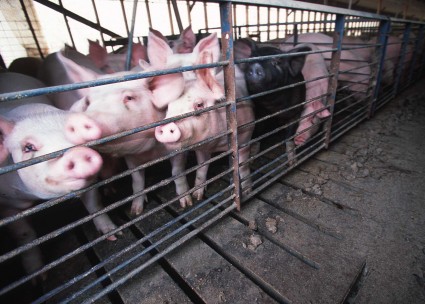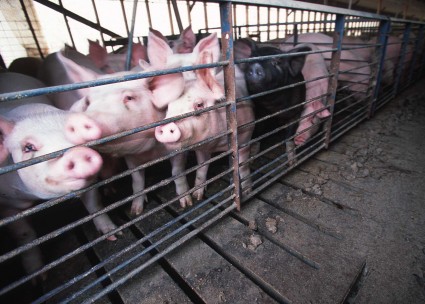 How is a massive hog farms like an open box of oily rags stored near a furnace? Photo courtesy of USDA Natural Resources Conservation ServiceAmid a trickle of news and science about swine flu over the past week, I’ve been rethinking my position on the novel H1N1 virus that has now infected millions of Americans (thankfully, so far, in a relatively benign way).
How is a massive hog farms like an open box of oily rags stored near a furnace? Photo courtesy of USDA Natural Resources Conservation ServiceAmid a trickle of news and science about swine flu over the past week, I’ve been rethinking my position on the novel H1N1 virus that has now infected millions of Americans (thankfully, so far, in a relatively benign way).
When I first began covering the story in April, I fixated on the question of origin. Had the new virus incubated in the vast hog confinements in Vera Cruz, Mexico? In a village near several large hog buildings there, a mysterious and virulent respiratory disease had broken out–and at least some of the cases were later confirmed have been infected with H1N1.
I still think it was right and proper to note the proximity between the CAFO and the outbreak. But now I think the focus on origins was wrong. Asking when and where this novel H1N1 strain mutated into present form is a bit like trying to identify the first mutant wolf pup that grew into a proper dog. In this context, origin is impossible to identify–and probably not that interesting.
The real question is, which of our practices are creating ideal conditions for the mutation of new swine-flu strains not recognized by human immune systems?
And once we identify those practices, we’d do well to phase them out. True, the current strain of H1N1 is behaving rather tamely–spreading fast but not causing much more damage than regular flu strains. And it has entered a phase of genetic stability–it hasn’t mutated much lately.
But what if it does begin to mutate–and new forms are more deadly, and resistant to Tamiflu? If and when it does begin to mutate, entire new vaccines will have to be generated–further straining a public health system already stretched to the limit by the current vaccine effort.
As anyone reading this already knows, I believe that concentrated animal feedlot operations (CAFOs) create excellent conditions for the mutation of new flu strains: thousands of genetically similar bodies living in close quarters, their immune systems compromised, swapping germs and occasionally coming into contact with human workers.
In its September issue, Environmental Health Perspectives ran an article called “Swine CAFOs and Novel H1N1 Flu: Separating Facts from Fears.” The article makes three main points: 1) that we’ll never know the precise origin of the current strain of swine flu that has caused a global pandemic; and 2) that CAFOs provide an excellent environment for the generation of new strains; and 3) that CAFOs operate under almost no oversight of public-health authorities.
The only current program for testing hog farms for the new H1N1 strain is voluntary–and CAFO operators are reportedly actively avoiding testing because they don’t want to risk losing their herds if an infection is found. And if operators do find H1N1 present, they’re encouraged but not required to report it.
Thus, given the incredibly slack nature of the oversight regime, no one can take comfort in the recent report of an H1N1 outbreak in an Indiana CAFO.
Or in the work of University of Arizona researcher Michael Worobey, who recently released research concluding that “This virus most likely has been circulating under the radar in pigs for the better part of 10 years.” In other words, not only is it currently appearing in CAFOs, but it’s been in CAFOs for a while, and only broke out into the human population this year.
Few people would knowingly store an open box of oily rags next to a furnace. Yet our meat-production system runs on just that kind of recklessness.



